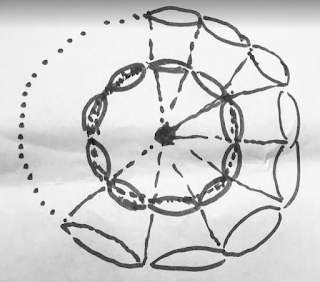I conceptualize learning as a self-changing process during
which my thinking is greatly influenced by experience with new information, or
the various sources of knowledge that I experience through my engagement with
other people, objects, situations, events, and most important of all, ideas. It
took me a long time to come to where and who I am. Along the way I had absorbed
a smorgasbord of specialized knowledge: linguistics, English literature,
language teaching and arts organization management. However, I experienced more
changes in the past two years of my Ph.D. grogram in LCLE than I had previously
experienced. James Paul Gee suggests people to beg, borrow, or steal new ideas
to become smart in this fast-changing and complex world. “It requires that all
of us, young or old, remain open to discovery and grow to be distrustful of
long-held and cherished beliefs that we have not closely inspected for a long
time (Gee, 2013).” This has been so true to me for the past two years during which
these “begged, borrowed and stolen new ideas” regenerated me by challenging my
old structure of knowledge and escalating me step by step from the little
confinement of my previous unreflective life to a much broader intellectual
landscape. Not exaggeratingly, I find myself a different person everyday with
my ontological self shaped and reshaped by the incorporation of new knowledge
into my old schemata.
This constant expansion of knowledge gives rise to the
change of lenses with which I look at things around me, and as a result, new
connections between two different things, or between my present and the past are
always built up. For example, I used to see language as a unique and the most
important means of communication. But semiotics enables me to see language as equal
as other signs of human communication, and human communication is multimodal. Significance
for this shift in perspective? Needless to say, linguistic theories—even those
that fuse language and social practice, such as Halliday’s Systemic Functional
Linguistic theory and Austin’s speech act theory—can no longer lend themselves
to the interpretation of such a changing landscape of communication, given the
ease with which images, sounds, and movement can be tapped for signification.
This is because the direction of the discipline in which Saussure (generally
believed to be the founding father of linguistics) leads is mainly concerned
with the signs themselves and the underlying structure which gives meaning to
each other, while unfortunately cutting the relation between the signs and the
realities they represent on the one hand and dismissing the significance of the
acting subject on the other.
This shift in perspective therefore enables me to see a
symmetry between the producer and receiver of the sign that contributes to the
success of a communication. It can also be paraphrased by citing Seboek (1994):
“signs have acquired their effectiveness through evolutionary adaptation to the
vagaries of the sign wielder’s Umwelt (p.12).” Paradoxically, the reductionist
perspective allows me to see permanency among fleeting changes, i.e. the circle
of communication remains the same if the internet and all those smart terminals
used for communication are just considered new extensions of perception human
beings have never ceased to create extensions of themselves) that have
constantly altered our Umwelt (Uexhüll, 1940). The crux of success still
consists in the ability of both the producer’s and the receiver’s mutual
understanding of these extensions. An interesting way to explain why the
internet tends to gather like-minded people together is that people with
similar Umwelts find communication easier and more economic because of their
symmetrical understanding of the signs produced by each other.
Sebeok, T. A. (1994). An introduction to semiotics. London:
Pinter Publishers.
Uexhüll, J. v. (1940). The
theory of meaning. Semiotica, 42 (1), 25-82.
 How I learn: I picture myself in the middle as a dot. I gain
knowledge through various sources and the new knowledge is connected with my
old knowledge (sometimes revolutionizes my old paradigm). At the same time, the
knowledge gained serve as lenses through which I look at the world around me or
make predictions about the future (the inner circle). These lenses enable me to
see more and farther, represented as the outer layer of knowledge, which can be
future lenses. This is how I model my intellectual growth. But there is a paradox:
the more I learn, the more uncertain I have become, and the more I realize how
small I am. This can be illustrated by the fact that as the known becomes
larger, represented by the expanding circles, there is more exposure to the unknown.
How I learn: I picture myself in the middle as a dot. I gain
knowledge through various sources and the new knowledge is connected with my
old knowledge (sometimes revolutionizes my old paradigm). At the same time, the
knowledge gained serve as lenses through which I look at the world around me or
make predictions about the future (the inner circle). These lenses enable me to
see more and farther, represented as the outer layer of knowledge, which can be
future lenses. This is how I model my intellectual growth. But there is a paradox:
the more I learn, the more uncertain I have become, and the more I realize how
small I am. This can be illustrated by the fact that as the known becomes
larger, represented by the expanding circles, there is more exposure to the unknown.
Comments
Post a Comment